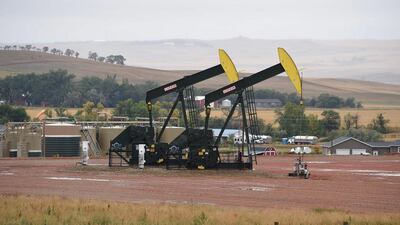Oil markets reached two-and-half year highs in December, with investor sentiment showing an increasing sharp contrast to the bearish tone of the last three years.
One unexpected result of the bearish energy market was US shale’s quick move to take up market share by boosting production. Instead of taking a cautious approach given the low oil price, the US industry decided to pick up steam. This only increased after Donald Trump was elected US president and the White House energy policy became that of energy dominance.
The deadlock that emerged between US shale and Opec producers set the tone for most of 2017. The economic pressure weighed on Opec members, which put some tailwind into the oil price by agreeing to cut supplies. At the same time, these efforts were matched each week by ever-increasing US Shale production.
It appears there is little chance of breaking this deadlock and it would not be in US shale’s interests to do so either. Earlier this year, talk of the US oil giants cooperating with Opec’s supply-cut policies soon trailed off after a clear lack of interest from the shale industry. That hasn’t prevented Opec leader Saudi Arabia from considering other options.
Saudi oil gargantuan Aramco is reportedly considering buying up US shale assets and has held talks with Houston-based energy company Tellurian. This makes sense for Saudi Arabia’s oil industry in several ways. When Aramco goes public, international holdings would benefit its portfolio. In addition, the Gulf state would increase its influence over the US industry. In big-picture terms, the benefits for the US shale industry are different. Companies that went heavily into investment may need cash to repay investors and cover the high costs of development, given the lower revenues from crude oil sales since 2014. Selling assets to overseas investors could be one solution for US shale companies.
______
Read more from Hussein Sayed:
Venezuela default - an opportunity or risk for Opec?
Gold trades lower but the dip may not last long
______
The factor that may trump dollars-and-sense deals between Opec member states and US shale is protectionism. Donald Trump is insistent on protecting American industries. His administration is intent on offering incentives like tax breaks to local companies to keep them investing inside the US. Pre-2014 and the financial pain resulting from low commodity prices made globalisation a beneficial business strategy. Post-Trump’s election, it has become a risky geopolitical minefield.
Given these factors, there is a risk that the deadlock will persist into 2018. Now that the dust is settling in the Middle East after regional tensions in the fourth quarter, fundamentals are making a comeback as the main market drivers. US crude and global inventories versus global demand would be the top driver to watch in the first quarter of this year.
API and IEA weekly reports will be the key to Brent Crude and other oil price benchmarks. If the backwardation trend first seen in oil markets in the fourth quarter persists and steepens, it would indicate a positive start for 2018. The same goes for reaching five-year historic averages for inventories. We could only expect price volatility in the case of unexpected market shocks like geopolitical events. Investors are still very conscious of the essential over-supply and the delicate relations holding Opec together.
That’s not to say that geopolitical factors aren’t an important consideration. Relations between Opec members Iran and Saudi Arabia appear to be the key geopolitical risk for oil markets. Much was written and said about the regional tensions, which are still simmering. As demand for oil picks up, possible future tensions could contribute to unexpected volatility in the first quarter of 2018.
Hussein Sayed is the chief market strategist at FXTM

